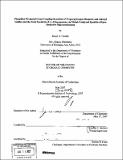| dc.contributor.advisor | Timothy F. Jamison. | en_US |
| dc.contributor.author | Trenkle, James D. (James Douglas) | en_US |
| dc.contributor.other | Massachusetts Institute of Technology. Dept. of Chemistry. | en_US |
| dc.date.accessioned | 2007-11-16T14:28:47Z | |
| dc.date.available | 2007-11-16T14:28:47Z | |
| dc.date.copyright | 2007 | en_US |
| dc.date.issued | 2007 | en_US |
| dc.identifier.uri | http://hdl.handle.net/1721.1/39582 | |
| dc.description | Thesis (Ph. D.)--Massachusetts Institute of Technology, Dept. of Chemistry, 2007. | en_US |
| dc.description | Vita. | en_US |
| dc.description | Includes bibliographical references. | en_US |
| dc.description.abstract | I. Phosphine-Promoted Cross-Coupling Reactions of Propargylcopper Alkenyl Iodides Reagents and Alkenyl Iodides. An electron-rich phosphine additive is critical and sufficient for propargyl-selective couplings of propargylcopper reagents and alkenyl iodides. This method is complementary to those previously described, in which high allenyl selectivity is observed in analogous coupling reactions. While the basis of the phosphine effect requires further investigation, the information gained in these studies enables the synthesis of complex molecules by way of skipped enyne intermediates. ... II. Total Synthesis of (-)-Gloeosporone via Nickel-Catalyzed Epoxide-Alkyne Reductive Macrocyclization. The total synthesis of macrolide natural product (-)-gloeosporone 1 is described in 10 steps (LLS) and 5.2% overall yield. The key macrocyclization was performed via nickel-catalyzed reductive macrocyclization of an alkyne and a epoxide to give the 14-membered ring in 46% yield (4a ---> 3a; up to 67% yield could be achieved with stoichiometric nickel). This transformation differs from previous strategies in closing the macrocycle of 1 using more traditional approaches such as macrolactonization and ring-closing metathesis. ... | en_US |
| dc.description.abstract | (cont.) Additional nickel-catalyzed macrocyclization studies of alkynes and epoxides were undertaken with other alkynylepoxides. With these studies we were able to recognize an important structural pattern (a 6,e-unsaturated ynoate) which might be necessary for efficient cyclization. Using this information, the nickel-catalyzed reductive cyclization of alkynes and epoxides was extended to the formation of 12- and 15-membered rings. | en_US |
| dc.description.statementofresponsibility | by James D. Trenkle. | en_US |
| dc.format.extent | 208 p. | en_US |
| dc.language.iso | eng | en_US |
| dc.publisher | Massachusetts Institute of Technology | en_US |
| dc.rights | M.I.T. theses are protected by copyright. They may be viewed from this source for any purpose, but reproduction or distribution in any format is prohibited without written permission. See provided URL for inquiries about permission. | en_US |
| dc.rights.uri | http://dspace.mit.edu/handle/1721.1/7582 | |
| dc.subject | Chemistry. | en_US |
| dc.title | Phosphine-promoted cross-coupling reactions of propargylcopper reagents and alkenyl iodides and the total synthesis of (-)-gloeosporone via nickel-catalyzed epoxide-alkyne reductive macrocyclization | en_US |
| dc.type | Thesis | en_US |
| dc.description.degree | Ph.D. | en_US |
| dc.contributor.department | Massachusetts Institute of Technology. Department of Chemistry | |
| dc.identifier.oclc | 174969871 | en_US |
